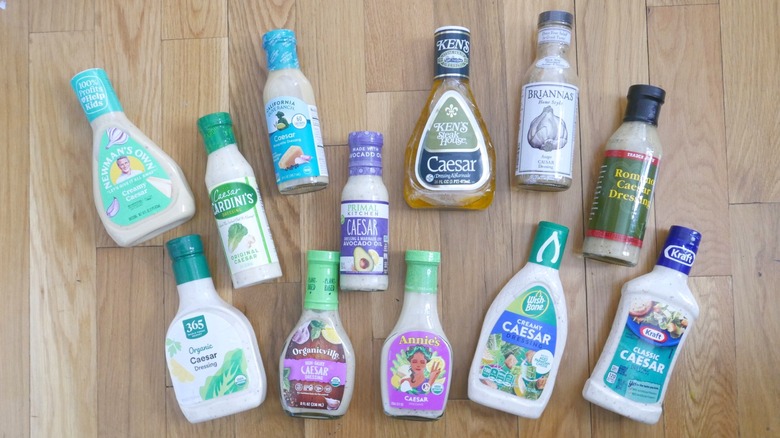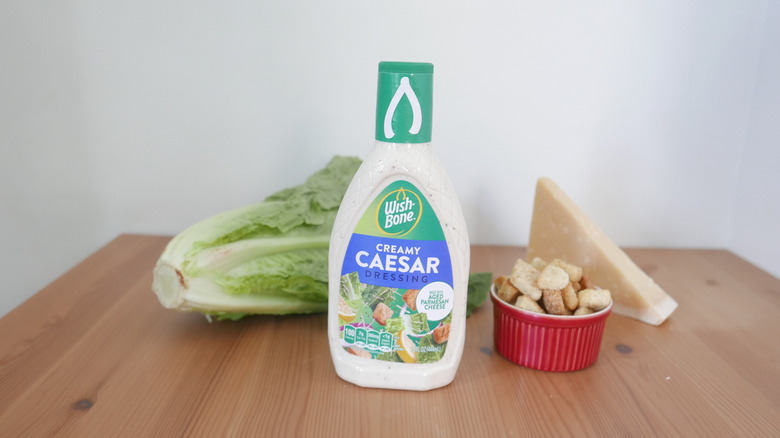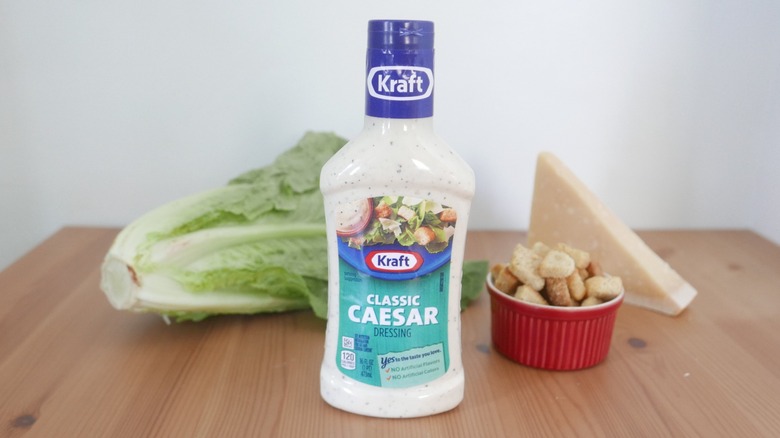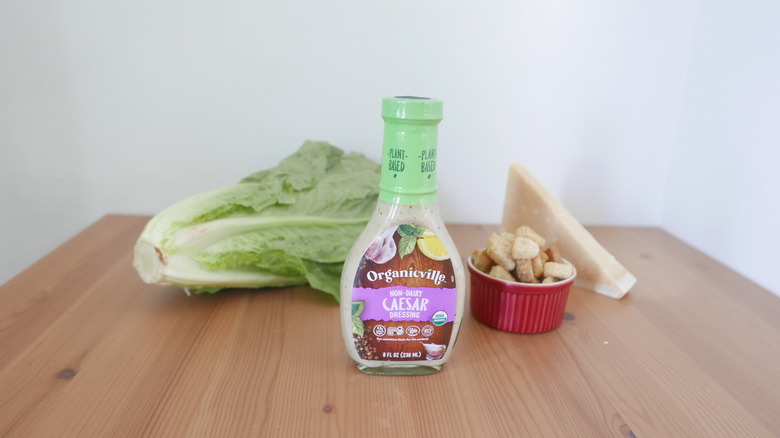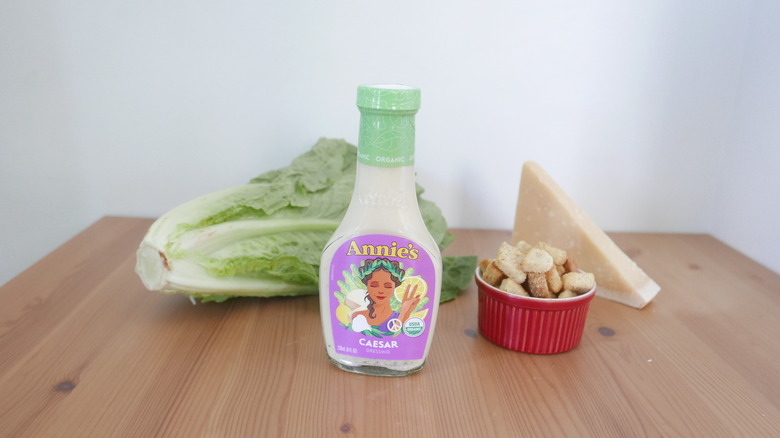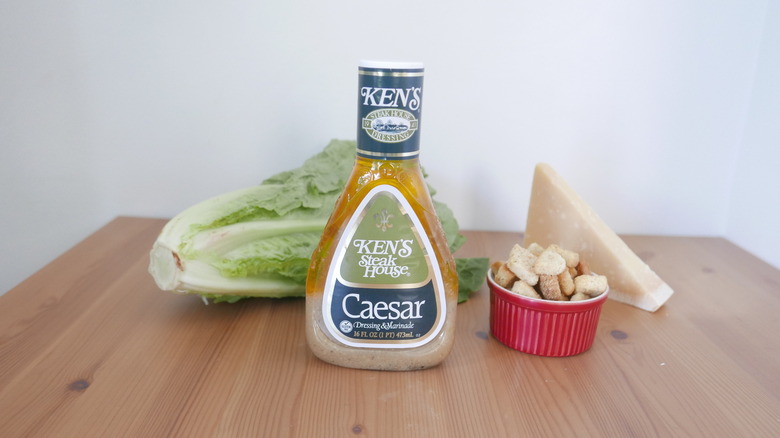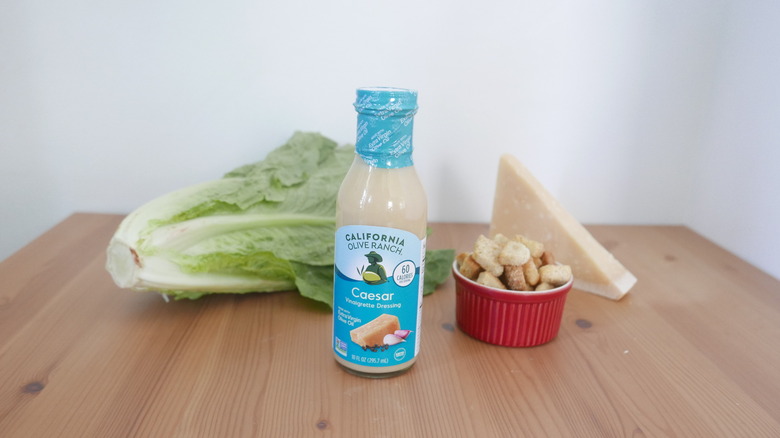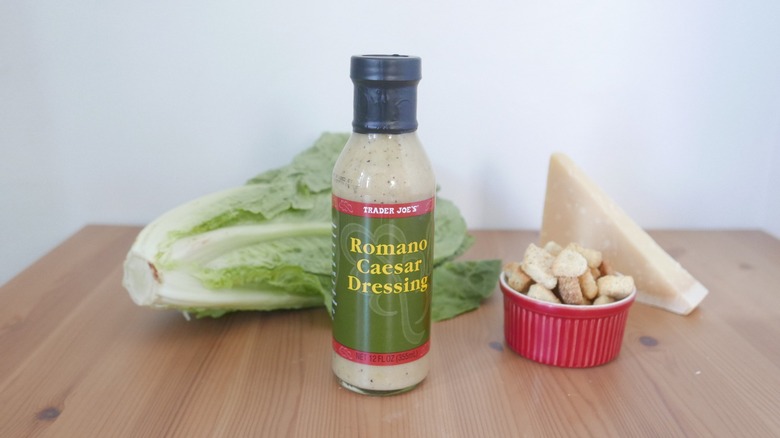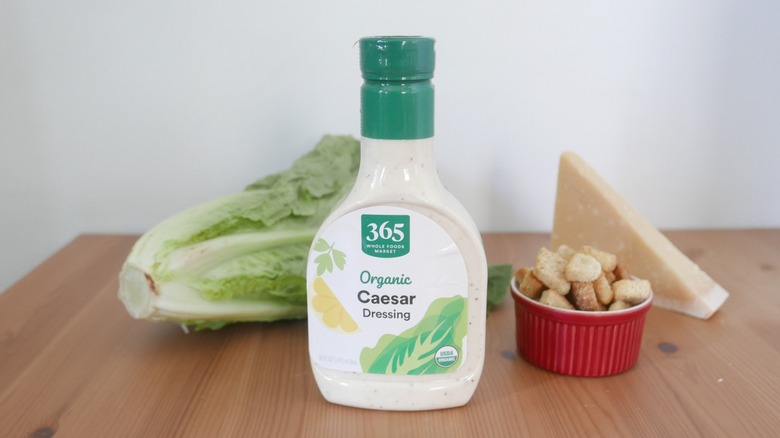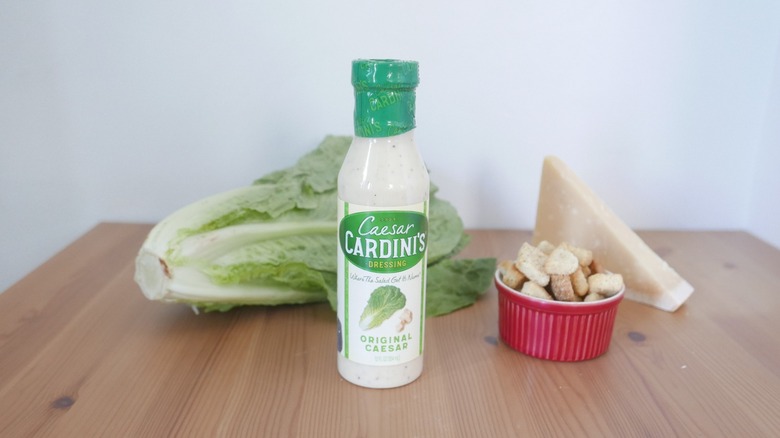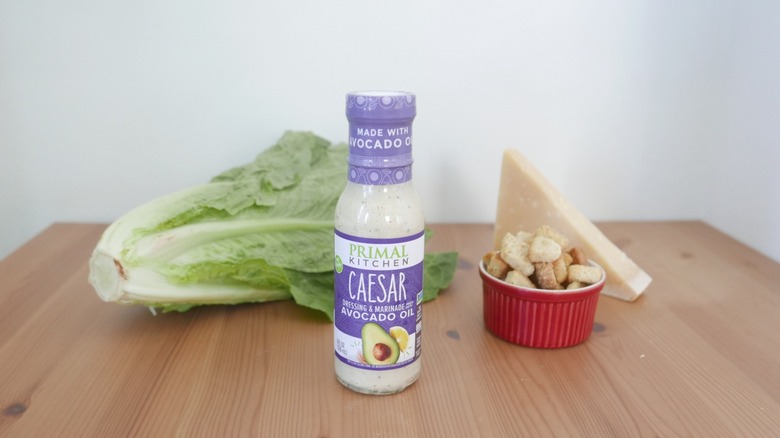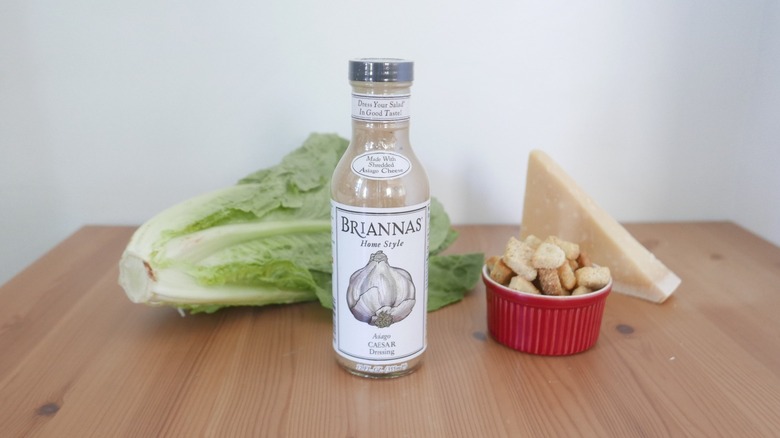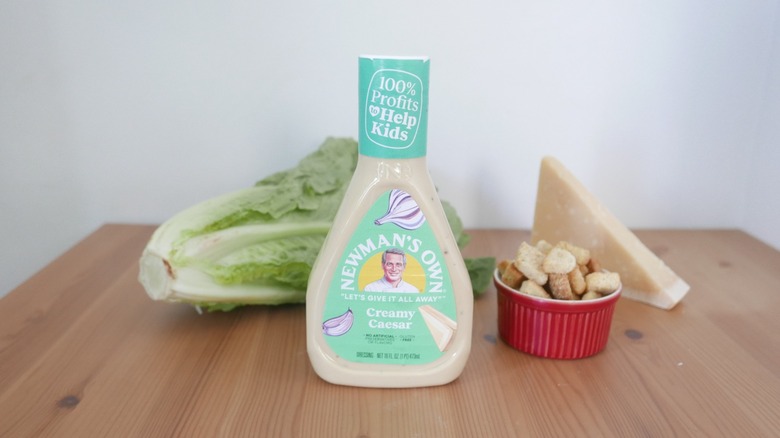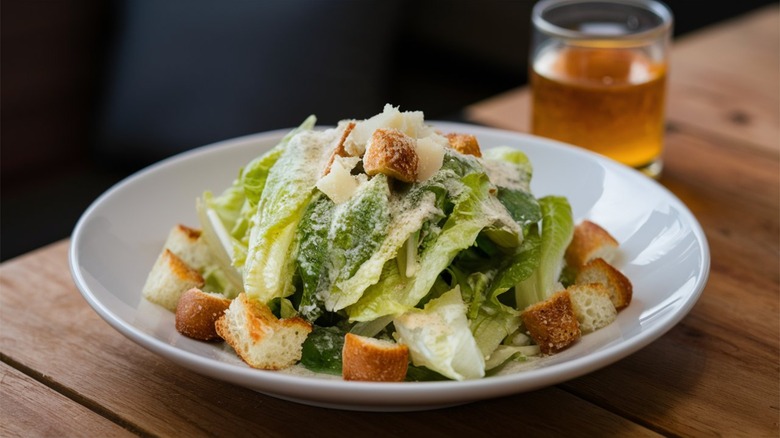12 Store-Bought Caesar Salad Dressings, Ranked
As we roll into summer, so begins the season of fresh fruits and crunchy salads. And for Caesar salad, this is a special year. In July, the crisp, creamy concoction that is Caesar dressing is turning 100, so don't forget to wish it a happy birthday, or should I say feliz cumpleaños?
What many people don't know is that Caesar salad was invented in Tijuana, Mexico. As the story goes, Caesar Cardini, an Italian immigrant, was running out of ingredients serving food to hordes of Americans eating at his restaurant, so he whipped up a salad with a dressing made of raw eggs, Parmesan cheese, olive oil, lime juice, Worcestershire sauce, and a dash of black pepper, topped it off with some crunchy croutons and sent it off. The humble dressing exploded in popularity and is now served all over the world.
As a San Diego native, I've traveled to Tijuana and enjoyed the spectacle of this salad made tableside by servers in suits. While you might call this the "authentic" Caesar experience, the dressing has evolved far beyond its humble origins. But the key factors (an acidic bite balanced by an oil along with an umami funk and an eggy richness) are still what makes this salad great. I wrangled some popular options available at grocery stores to find out which Caesar dressings are worth buying and which you can leave on the shelf. Read on to find out which store-bought Caesar dressing reigned supreme.
12. Wish-Bone
Taking a bite of a Caesar salad, you'll likely notice a tangy egg flavor that may remind you of mayonnaise. But this Wish-Bone Caesar dressing tasted more like a cheap, thinned out mayonnaise than it did salad dressing. The texture was also too thick, and it was difficult to coat the romaine leaves evenly.
The dressing lacked the signature umami Parmesan punch that is the hallmark of a Caesar dressing worthy of the name. Turn this bottle around, and you'll notice that the ingredient list is the length of a short novel. Among the compounds included in this dressing are preservatives with names like potassium sorbate and sodium benzoate. Although it's FDA approved, it doesn't exactly make your mouth water. It also left an oily, unpleasant aftertaste that had a slightly chemical flavor — hardly what I'm looking for when I want to enjoy a salad. Despite its affordable price point, Wish-Bone left me wishing for more.
11. Kraft
A classic household name in the U.S., Kraft Heinz produces some of the country's most beloved snacks and condiments. But this Caesar dressing was not exactly crafted with authentic Caesar dressing flavor in mind. Although the dressing lists both Parmesan and Romano cheeses as ingredients, it's barely perceptible behind a generic-tasting salad dressing that could easily be mistaken for ranch.
Likewise, Kraft Caesar contains egg yolks, but these were also lost in the sauce, and the only strong flavor that came through was a vague acidic tang mixed with pepper. The dressing was slightly sweet, and it contained dubious-sounding ingredients like disodium guanylate and calcium disodium EDTA. These may be safe to eat, but it doesn't exactly sound appetizing. The consistency of the dressing was thick and it stuck to the lettuce leaves in large globs that were difficult to distribute throughout the salad. The taste wasn't necessarily bad, but it just didn't taste like Caesar.
10. Organicville
I can't imagine it's easy to come up with a vegan, non-dairy Caesar salad dressing. So much of what makes Caesar great is eggs and cheese, so I was pleasantly surprised to find that a crunchy romaine leaf anointed with some Organicville Caesar dressing was not bad. There's a nice balance of acid and oil, along with a salty kick and a lemony zing. Why all the praise if this dressing is ranked so low? Because it doesn't taste like Caesar dressing.
The cheesy umami flavor of sharp parmesan that I yearned for was nowhere to be found, nor was the mild egginess. The texture was also a bit off as well; it was too thick to easily shake out of the bottle and I had to use a butter knife to get it flowing. While I'm glad somebody's making vegan Caesar dressing, and it's probably a good business decision based on the fact that dairy alternatives are expected to spike in popularity, this dressing missed the mark.
9. Annie's
As a die-hard fan of Annie's mac and cheese, I was hoping this brand would be able to hit it out of the park in every category. And while Annie's Caesar dressing wasn't bad, it also wasn't great. The biggest issue is that it was too acidic. The taste of apple cider vinegar comes through too strongly, giving the dressing a sharp tang that obscures the flavor of the parmesan. Other ingredients listed on the bottle, like black pepper and garlic, were similarly invisible to the palate.
I was able to get some of the characteristic cheesy funk that I was looking for in the aftertaste, but it left me longing for more. Texture-wise, however, Annie's was near perfect. Just thick enough to feel substantial without getting globby or veering into mayonnaise territory, and it makes for an easily tossable salad that's easy to coat evenly. It also had just a bit of grit from the parmesan that gave it some body.
8. Ken's
You can tell at first glance that Ken's Caesar salad dressing isn't like the rest. While all the other dressings in this lineup are emulsions, meaning the oil and vinegar have been blended together to create a creamy, texturally uniform sauce, the ingredients in Ken's are separated, so it needs a vigorous shake before you start dressing salad. It's also the only bottle on this list labeled as both a dressing and a marinade.
These factors may explain why the flavor of Ken's was a bit off, but that shouldn't excuse it. Firstly, the dressing was too salty, and it didn't have enough of an acidic bite to balance out the salt content. Ken's used Romano cheese, which is deliciously sharp and provides a similar umami flavor as Parmesan, but it's also saltier, which could have contributed to its briny flavor. The texture was more akin to a vinaigrette than a Caesar, but it was still perfectly acceptable. And for a deliciously cohesive Caesar salad, marinate the chicken in Ken's since the added saltiness is perfect for a marinade because it interacts with the meat to draw in moisture and flavor.
7. California Olive Ranch
True to its name, California Olive Ranch Caesar is the only dressing on this list to exclusively use olive oil as a fat. And it does score some points for the authenticity factor (the original Caesar salad dressing used only olive oil) as well as the more nuanced flavor that olive oil lends the dressing compared to canola or soybean oil, which is what most of the other dressings use. Beyond that, however, the taste is lost with an overabundance of acidic flavor that comes from white wine vinegar and the spicy bite of Dijon mustard. To be fair, it's labeled as "vinaigrette dressing," which may account for the overabundance of vinegar.
There are chunks of grated parmesan that you can see and feel, but the flavor of the cheese is obscured behind a curtain of acidity. Likewise, there's no egg, so the dressing doesn't have the subtle mayonnaise tang that should be present in Caesar. As far as texture, though, this dressing is just about perfect. The liquid is nicely emulsified, has a creamy consistency without getting too thick and globby, and coats the leaves with just enough dressing to keep you reaching for one more bite of salad.
6. Trader Joe's
Famously one of the country's most consistent purveyors of high-quality, low-cost groceries, Caesar salad dressing by Trader Joe's is the average Joe of the group. Not at all offensive, but neither remarkable, this dressing is a solid choice for the low price. If you happen to be at Trader Joe's and you need Caesar salad dressing, it's perfectly acceptable, but I wouldn't go out of my way for it.
The first thing I noticed was that it uses a blend of canola and olive oils and although the olive oil is mostly hidden, it does add a subtle hint of complexity. And while the Romano cheese doesn't really shine through, this dressing contains capers and anchovies, both of which provide some umami saltiness that's satisfying enough. The consistency is also just fine: thin enough to easily coat your romaine and croutons and thick enough to lend your salad a nice heartiness. I'd buy Trader Joe's Caesar again, but I'd just as easily forget it.
5. 365
365 brand foods are often among the pantry staples you should grab from Whole Foods when you shop there. As Whole Foods' signature brand, 365 often offers organic foods at a great price, and Caesar salad dressing is no exception. This dressing is fully organic and boasts all the right ingredients on the back of the bottle. However, while the dressing is not bad, it's also nothing special.
365 is perfectly suited as an affordable, widely accessible option to keep in your fridge if you like to eat organic groceries. It hits the necessary notes of creaminess and has a nice balance of oil and acidity, but the umami tang that I want from the Parmesan cheese is lacking here. The consistency is a bit on the thick side, which is great for those who like a heftier salad. There's also no sign of the eggy flavor I'm always hunting for in a good Caesar salad.
4. Caesar Cardini's
While most of the brands on this list make a wide array of products, Cardini's stakes its claim on Caesar dressing. The company is named after Caesar Cardini, the inventor of the sublime salad that bears his name, and Cardini's claims on its website that "this is his dressing." While it's worth noting that the original Caesar salad differed from today's classic in some significant ways, this dressing conveys a delightful, balanced flavor that pays homage to the king of Caesar himself.
When I read the ingredients list, which sports some unattractive words like potassium sorbate and calcium disodium EDTA, I suspected that Cardini's would land itself on the lower end of the list, but I was pleasantly surprised. The acidic tang was just strong enough to stand up to the oil and the flavor of Parmesan cheese was notable, along with a subtle egginess. Anchovies weren't part of the original Caesar dressing, but their presence in this dressing added a great umami boost and rounded out the flavor. The only downside to this dressing was that the consistency was a bit thick and too similar to mayonnaise.
3. Primal Kitchen
One of my main issues with most of the dressings on this list is the lack of cheese flavor, so when I saw that Primal Kitchen's Caesar dressing doesn't contain any cheese, I was steeling myself for another sub-par dressing experience without enough umami flavor. But I was thrilled to be proven wrong. The flavors in the dressing were perfectly balanced, working in concert with one another to deliver a whole that is greater than the sum of its cheeseless parts.
Upon closer review of the ingredients list, I discovered that this dressing contains nutritional yeast, which explains why I detected a cheese-adjacent flavor. While this is an unorthodox approach to Caesar, it delivers what a discerning dressing eater demands. Primal Kitchen also had the most eggy flavor of any dressing on the list. As someone who has eaten many a Caesar salad made tableside in Tijuana, this salad's birthplace, I know the richness that eggs can bring to this salad. The only negative thing about this dressing is that it was far too thick. I had to use a knife to get it out of the bottle, and it was so thick, I could've used it as a sandwich spread. Overall, though, Primal Kitchen is a fantastic choice.
2. Briannas
Several unconventional choices went into the creation of Briannas Caesar dressing. First, the acidic element was achieved not by lemon juice, apple cider vinegar, or white wine vinegar as it was in most dressings, but with balsamic vinegar. Balsamic is complex, fruity, and sweet, but it turns out it makes for a great Caesar, at least the way Briannas does it. The other curveball was the use of Asiago cheese instead of the more commonly employed Parmesan and Romano. Nuttier, creamier, and less salty, the Asiago gives this dressing a nice funky flair.
What's great about these alternative ingredients is that they conspire to make a dressing that incorporates the acidic, oily, and umami flavors that go into a classic Caesar. Briannas is a great example of what happens when you get creative with ingredients while still respecting the end goal which in this case, was to make a dressing recognizable as Caesar. The consistency is thin enough to pour easily from the bottle and thick enough to linger on your tastebuds.
1. Newman's Own
It's hard not to love Newman's Own just by looking at the bottle, with the friendly visage of Paul Newman staring back at you with a contented smile. It's also impossible not to get behind the ethos of the company, which has donated more than $600 million since its inception in 1982. But I'm not here to judge salad dressings for their good deeds.
And I'm pleased to report that Newman's Own holds its own in the flavor department. This tastes like a true Caesar: First comes a gentle hit of acid from the vinegar, then a wave of canola and olive oils, followed by the richness of egg yolk and the funky, salty tang of Parmesan. True to the original Caesar, this dressing contains Worcestershire and lemon juice concentrate, each of which adds complexity and depth to the festival of Caesar dressing that is celebrated on your taste buds. The texture is creamy and just the right amount sticks to the lettuce when it's tossed. You could use this dressing outside of making salad. I'd even be tempted to use it as a dip for fries or substitute it for mayonnaise in a chicken wrap. For its killer reviews in every category, Newman's Own earned the top spot in this battle for Caesar supremacy.
Methodology
Since the inception of this famous dressing almost a hundred years ago, Caesar dressing has come to encompass flavors and ingredients way beyond the original recipe. Nowadays, it's not just used on leaves of romaine lettuce. You can use Caesar instead of mayonnaise on a wrap or add pasta to chicken Caesar salad for an appetizer and entree. So, how does one judge an ingredient subject to such a wide interpretation?
What makes Caesar a fantastic dressing is beyond the specific ingredients used in the original recipe. The spirit of the dressing is an emulsion of oil and acid with a strong umami taste and an eggy richness. While this is easily achieved using the original ingredients (eggs, olive oil, lime juice, Worcestershire sauce, Parmesan cheese, and black pepper), there is room for variation so long as it achieves what a Caesar was meant to achieve. To test these dressings, I first drizzled each one over a bed of a few romaine leaves and tossed them to get a sense of the consistency and how well it coated the lettuce. Next, I took a few bites of the salad, looking for a creamy texture that carried a salty, tangy, slightly funky flavor. I took into account the ingredients and price, making a final judgement based on a combination of these factors.
